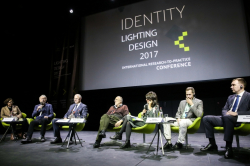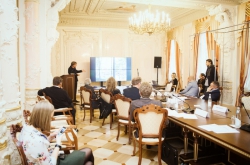Natural vs artificial lighting
Architects and lighting designers rely on two main principles when choosing how to illuminate architectural monuments. According to the first principle, when working with cultural heritage sites, artificial light should be used minimally because it distorts the true appearance of the building. Thus, artificial lighting prevents us from seeing the structure as its architect intended, especially since many architectural masterpieces were created before the invention of electricity and were designed without this factor in mind. Additionally, artificial light can quickly alter the color rendering of facades. Moreover, bright lighting can shift viewer impressions and draw attention to specific details, obscuring the overall picture.
Proponents of the second principle argue that it’s hard to imagine iconic structures like the Acropolis, Notre-Dame de Paris, or the Winter Palace remaining completely unlit. These monuments attract millions of tourists, many of whom cannot visit during the day. We are accustomed to uniformly spread lighting in major cities, making it odd to leave historical sites as dark spots on the map. Moreover, well-designed lighting can enhance a building’s historical appearance and create a unique image that elicits an emotional response from viewers.

International forum Light for Humans. Photo by Dmitry Grigoryev / ITMO.NEWS
Changing spaces with light
Light isn’t just a practical way to make things visible in the dark. For lighting designers and architects, light is one of the elements of creative expression. It can be used to change the appearance of an environment or imbue an object with new visual features. These principles have been used by architects for centuries.
Before the advent of artificial lighting, a building’s lighting model would take into account the changes in lighting during the day:
- where it came from: north, south, west, or east;
- how intensive it was: was the sun rising, going down, or at its zenith;
- the light’s hues: warm, cold, or sunset-colored;
- the amount of daylight hours.
These characteristics were used to create a light movement scenario, accounting for how and when it changed the space. This made it possible to “layer” light from the north and south, warm and cool, daytime and sunset. As a result, the image of the building became more three-dimensional, varying at different times of day and in different weather conditions.

Oleg Yavein. Photo by Dmitry Grigoryev / ITMO.NEWS
“Light was seen as a living being. But most importantly, architects took into account its heterogeneity. Natural light is actually many projections of different wavelengths and hues. It also doesn’t only come from above, it also falls from the side. Light is a movement trajectory. And architects can change it for various purposes, such as casting light on a picture at a museum or an image in a church,” says Oleg Yavein, an associate professor at the Moscow Architectural Institute and a PhD in architecture.
A light model of a space is designed with two main tools: regular windows and skylights or attic windows. These windows are also referred to as “lanterns” by architects. They can come not only in the familiar round or square shapes, but also in forms like pyramids, cones, and other figures. Additionally, lanterns can be combined to achieve the desired light diffusion effect.
Currently, most Russian architects create models of cultural heritage sites with both internal and external artificial lighting. However, during the reconstruction of the Hermitage’s General Staff Building in the early 2000s, the designers took a different approach. They continued the traditions of renowned architect Rossi and worked with natural light. According to one of the project's authors, a senior partner of the architectural bureau Studio 44, Nikita Yavein, this allowed them to preserve one of the main museum principles – that paintings should “see the sky” – and to create a unique atmosphere in each hall.

International forum Light for Humans. Photo by Dmitry Grigoryev / ITMO.NEWS
Working with artificial light
In order to create a successful lighting project for an architectural site, experts follow these principles:
Comply with local regulations. Those outline the permitted technological specifications and lighting intensity.
Develop a general lighting concept. Light has to cover the entire building uniformly. Accents are placed depending on the significance of each section; but the main idea that ties them all together is crucial.
Consider many factors. When selecting the most effective tools for implementing an idea, designers pay attention to the concept and style of the building, as well as the intensity, power, spectrum, and saturation of light that the chosen equipment can produce. They also consider such parameters as the brightness of light from the source, the light contrast between objects and their surroundings, the conditions for interaction between light flows and their directions, the time viewers take to perceive the object, light adaptation, and lighting techniques.
Include the objects in its surroundings. Here, it’s crucial not to disturb the environment. Overly bright light can even be harmful for people and animals, especially birds.
Preserve the place’s “memory.” This is achieved by reconstructing the site’s original objects instead of creating new ones.
Be present at the site. This can help prevent mistakes at early stages.

International forum Light for Humans. Natalia Bystriantseva. Photo by Dmitry Grigoryev / ITMO.NEWS
One of the main challenges faced by architects and lighting designers today is the over-illumination of urban buildings. Since there is no established maximum brightness for buildings, modern structures are often lit much brighter than cultural heritage sites. As a result, heritage sites can get lost among the backdrop of such excessively illuminated buildings. A potential solution to this issue could be the development of a comprehensive city-wide lighting plan by the authorities.
Among other common mistakes made by contemporary designers, Natalia Bystriantseva, a PhD in architecture, a representative of ITMO’s Institute of Design & Urban Studies, and the head of ITMO’s International Laboratory of Lighting Design, points out the tendency to focus on objects rather than people. Often, projects are created without considering the angles from which viewers will perceive the building. Consequently, the object is lit primarily for itself.
“A lighting designer plots the path each person takes as they get to know an architectural site. Every step is important: here, they might slow down to look at the details; here, they might speed up a little, and at this point they are going to stop for a picture. We have to anticipate these things. And depending on this scenario, we have to create a lighting model, using specific tools at each point. We design a viewer’s impressions – it’s like a movie, but one where we take the place of the characters,” says Natalia Bystriantseva.

International forum Light for Humans. Photo by Dmitry Grigoryev / ITMO.NEWS
This article is based on the discussion Architecture and Light. Creating a Lighting Model and Preserving Cultural Heritage Sites. Among the speakers were Natalia Bystriantseva, a leading expert in lighting design and modernization of urban spaces and unique architectural objects in Russia; Roberto Corradini and Marco Palandella, world-renowned Italian architects; Alexander Isaev, the main power engineer at the Hermitage; Nikita Yavein, the founder, head, and a senior partner at the architectural bureau Studio 44, and Oleg Yavein, PhD in architecture, an associate professor at the Moscow Architectural Institute. The discussion was held at the first international forum Lighting for Humans, an event that brought together over 3,000 participants from all over the world. Lectures, workshops, and discussions were held by more than 100 experts from various countries.





